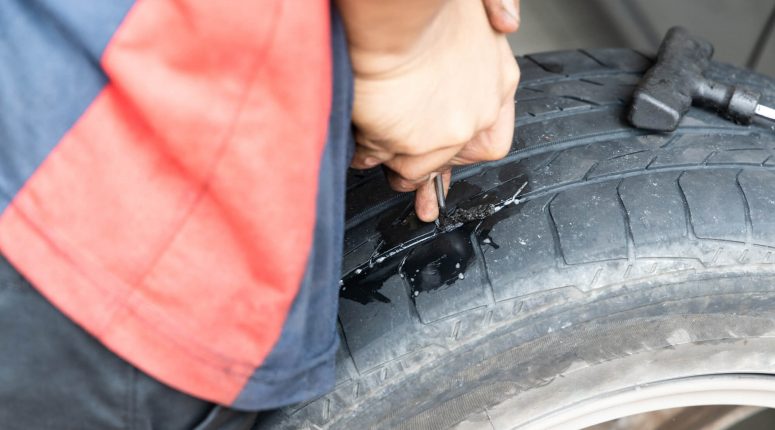Stuck on the Side of the Road? A Guide to Patching Your Tire and Getting Back on Track
A flat tire can bring your journey to a screeching halt, leaving you stranded and frustrated. But fear not, weary traveler! Patching a tire is a relatively quick and straightforward solution that can get you back on the road in no time. This comprehensive guide explores the timeframe involved in patching a tire, outlining the factors that influence the process, and offering guidance on deciding between patching and replacing your tire.
The Patchwork Process: Understanding the Timeline
The time it takes to patch a tire can vary depending on several factors. Here’s a breakdown of the typical steps involved and their estimated timeframes:
-
Preparation (5-10 minutes): This involves removing the flat tire from your vehicle, jacking it up securely, and locating the puncture.
-
Tire Inspection (5-10 minutes): A qualified mechanic will thoroughly inspect the tire for damage severity, size, and location of the puncture.
-
Patch Application (15-20 minutes): The damaged area is prepped, and a patch is applied from the inside of the tire to seal the hole.
-
Curing and Reassembly (20-30 minutes): The patched area needs time to cure properly. Once cured, the tire is reassembled onto the rim, balanced, and remounted on your vehicle.
Factors Affecting Patching Time:
Several factors can influence the time it takes to patch a tire:
-
Severity of the Damage: Larger punctures or those located on the sidewall typically require a more involved repair process, potentially extending the patching time.
-
Mechanic’s Experience: A skilled mechanic can perform the patching process efficiently, while someone less experienced might take longer.
-
Shop Workload: If the repair shop is busy, there might be a wait before your vehicle is serviced.
-
Tire Size and Type: Larger tires or those with run-flat technology might require additional steps or specialized equipment, potentially affecting the timeframe.
Patching vs. Replacing: Making an Informed Decision
While patching a tire is often a viable option, some situations might necessitate a full tire replacement:
-
Multiple Punctures: If the tire has several punctures, patching might not be the most reliable solution. Replacing the tire provides better long-term peace of mind.
-
Sidewall Damage: Patches are generally not recommended for punctures on the sidewall, which experiences significant flexing during driving. In this case, replacement is the safer option.
-
Tire Age and Treadwear: If your tire is nearing the end of its lifespan or has significant treadwear, patching might not be the most economical choice. Consider replacing the tire for overall safety and performance.
When in Doubt, Consult a Professional:
If you’re unsure whether patching or replacing your tire is the best course of action, err on the side of caution and consult a qualified mechanic. They can assess the damage, advise you on the most suitable option based on your specific situation, and get you back on the road safely and efficiently.
DIY Patching: A Word of Caution
While patching a tire is theoretically possible as a DIY project, it’s important to exercise caution. Improper patching can compromise the integrity of the tire and pose safety risks. If you’re not confident in your mechanical skills or lack the necessary tools, consider leaving it to a professional.
The Importance of Maintaining Proper Tire Care
Regular tire maintenance is crucial for preventing flats and ensuring a smooth ride. Here are some tips:
-
Maintain Proper Tire Pressure: Check your tire pressure regularly and inflate them to the recommended level as specified in your vehicle’s owner’s manual.
-
Inspect Your Tires for Damage: Visually inspect your tires regularly for any signs of wear, cuts, or bulges.
-
Rotate Your Tires Regularly: Regular tire rotation helps ensure even wear and tear, extending the lifespan of your tires.
Conclusion:
Patching a tire can be a time-saving and cost-effective solution for a flat tire, typically taking between 45 minutes and an hour, depending on various factors. However, proper assessment of the damage and consideration of your tire’s overall condition are crucial for making an informed decision between patching and replacing the tire. Remember, prioritizing safety should always be your top concern. By understanding the patching process, the influencing factors, and when to seek professional help, you can handle a flat tire situation with confidence and get back on the road in a timely manner.
Frequently Asked Questions (FAQ):
- Can I patch a tire myself?
Patching a tire is technically possible as a DIY project. However, it requires specific tools and proper technique.






More Stories
Where to Watch USMNT vs Jamaica National Football Team
How I Met My Monster
How Should a Ring Fit